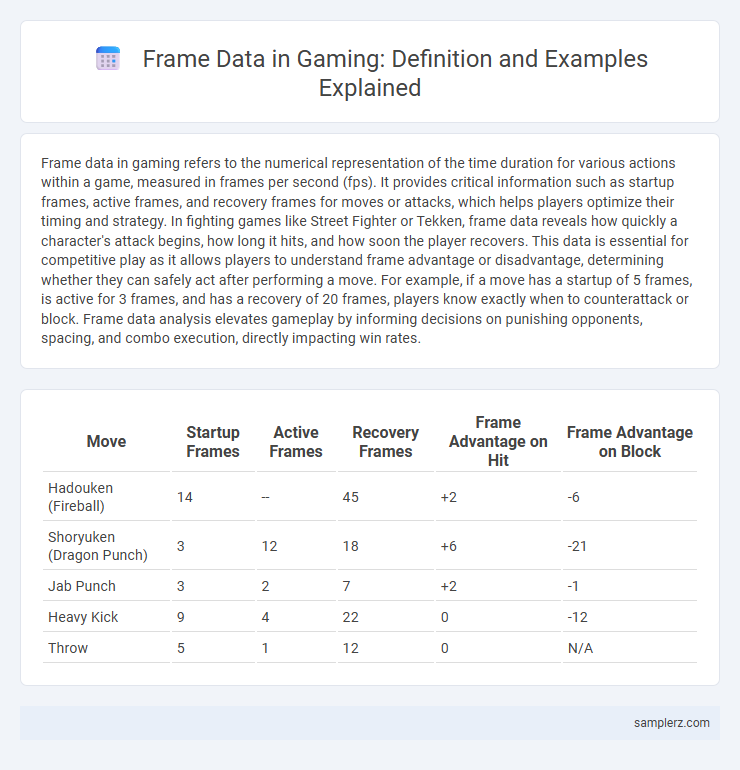Frame data in gaming refers to the numerical representation of the time duration for various actions within a game, measured in frames per second (fps). It provides critical information such as startup frames, active frames, and recovery frames for moves or attacks, which helps players optimize their timing and strategy. In fighting games like Street Fighter or Tekken, frame data reveals how quickly a character's attack begins, how long it hits, and how soon the player recovers. This data is essential for competitive play as it allows players to understand frame advantage or disadvantage, determining whether they can safely act after performing a move. For example, if a move has a startup of 5 frames, is active for 3 frames, and has a recovery of 20 frames, players know exactly when to counterattack or block. Frame data analysis elevates gameplay by informing decisions on punishing opponents, spacing, and combo execution, directly impacting win rates.
Table of Comparison
| Move | Startup Frames | Active Frames | Recovery Frames | Frame Advantage on Hit | Frame Advantage on Block |
|---|---|---|---|---|---|
| Hadouken (Fireball) | 14 | -- | 45 | +2 | -6 |
| Shoryuken (Dragon Punch) | 3 | 12 | 18 | +6 | -21 |
| Jab Punch | 3 | 2 | 7 | +2 | -1 |
| Heavy Kick | 9 | 4 | 22 | 0 | -12 |
| Throw | 5 | 1 | 12 | 0 | N/A |
Understanding Frame Data: Key Concepts in Gaming
Frame data in gaming refers to the specific duration, measured in frames, of animations such as attack startup, active hitbox, and recovery time. Understanding frame data allows players to optimize timing, execute precise combos, and effectively punish opponents' moves. This concept is critical in competitive fighting games like Street Fighter and Tekken, where even a few frames can determine the success or failure of an action.
Importance of Frame Data for Competitive Gamers
Frame data reveals the precise duration of each move's startup, active, and recovery frames, enabling competitive gamers to execute attacks and defenses with impeccable timing. Mastery of frame data allows players to optimize combos, punish unsafe moves, and predict opponent actions, directly influencing match outcomes. Understanding frame data sharpens strategic decision-making and elevates gameplay consistency in high-level competitions.
Basic Anatomy of Frame Data: Startup, Active, and Recovery Frames
Frame data in gaming breaks down into three key components: startup frames represent the initial delay before an attack hits, active frames indicate the duration the attack can hit the opponent, and recovery frames detail the time needed before a character can perform another action. For example, a punch might have 5 startup frames, 3 active frames, and 10 recovery frames, influencing combo timing and defensive options. Understanding these elements helps players optimize their strategies and improve reaction times in competitive gameplay.
Frame Data Example: Street Fighter V’s Ryu Hadoken
Street Fighter V's Ryu Hadoken has a startup frame data of 14 frames, meaning it takes 14 frames before the attack becomes active. The move's active frame lasts for 2 frames, and it recovers in 45 frames, allowing players to understand the timing and risk involved in executing this projectile. Understanding these specific frame data values helps players optimize their attack strategies and defensive reactions during competitive matches.
Breakdown of Mortal Kombat 11’s Scorpion Jab Frame Data
Scorpion's jab in Mortal Kombat 11 has a startup of 7 frames, making it a quick and reliable tool for interrupting opponents. The move recovers in 14 frames, allowing players to return to a neutral stance swiftly for follow-up attacks. With a block advantage of +1 frame, this jab can maintain offensive pressure and control space during close-quarters combat.
Analyzing Frame Advantage and Disadvantage in Tekken 7
Frame data in Tekken 7 reveals the frame advantage or disadvantage of specific moves, crucial for strategic gameplay. For example, a jab move with +3 frame advantage allows a player to act before the opponent recovers, enabling faster follow-ups or pressure. Understanding these precise frame timings enhances decision-making and punishes, elevating competitive performance in Tekken 7.
Using Frame Traps: Examples from Super Smash Bros. Ultimate
Frame traps in Super Smash Bros. Ultimate involve creating pressure by using moves with specific frame data to bait opponents into attacking during their vulnerable frames. For example, players often use Peach's down tilt (d-tilt), which has a fast startup of 5 frames and -2 on block, followed by a quick jab with an active frame of 3 to capitalize on the opponent's punished moves. Understanding precise frame advantage and disadvantage allows players to chain attacks effectively, maximizing pressure and combo potential.
Punish Windows: Frame Data in Soulcalibur VI
Punish windows in Soulcalibur VI refer to the specific frames during which a character can effectively counterattack after an opponent's move is blocked or missed. The game's frame data shows that many punishable moves have recovery frames ranging from 15 to 25, giving players precise timing to launch combos or high-damage attacks. Mastering these frame windows allows competitive players to maximize punishes, improving match outcomes and defensive strategies.
Training Tools for Learning Frame Data in Fighting Games
Training tools like FrameData and Aufrechten help players analyze hitbox timings, move startup frames, and frame advantage in fighting games with precision. These tools display frame-by-frame data for attacks, enabling gamers to optimize combos, punish unsafe moves, and improve reaction times during matches. Access to detailed frame data through such training software enhances strategic gameplay and competitive performance.
How to Apply Frame Data Knowledge in Real Matches
Understanding frame data allows gamers to analyze the startup, active, and recovery frames of moves, enabling precise timing for attacks and defenses. By applying this knowledge, players can identify safe moves, punish opponents' unsafe actions, and optimize combos for maximum damage efficiency. Mastery of frame data translates into improved decision-making, reaction time, and overall competitive performance during real matches.

example of frame data in gaming Infographic
 samplerz.com
samplerz.com